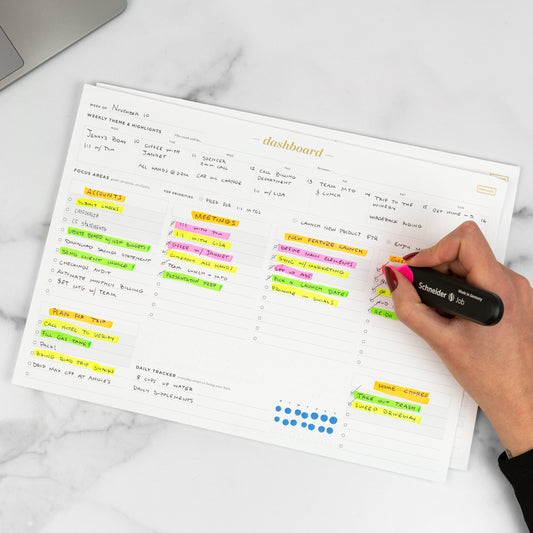Goals add meaning and purpose to our lives.
There’s nothing like waking up everyday with a fire burning in your belly and the desire to set out and achieve your biggest dreams.
Much like reaching the summit of a mountain or sprinting to the end of a finish line, reaching a goal can feel deeply satisfying, and make you realize just how much you are truly capable of.
At the same time, the goal setting process can be a bit elusive. You may know what your ultimate goal is (e.g. a dream job or a dream house), but how do you go about achieving that exactly?
Some common questions around the goal setting process include:
- What if I don't have any goals?
- How do I know which goal is the right one for me?
- Is my goal unrealistic?
- How long do I work on a goal?
- Do I pick a new goal every month or year?
These are all questions we’ve probably had at some point with our goals. That’s why we’ve put together this guide to take the mystery out of goal setting and help you define your goals and create an action plan.
We’ll go over:
- How to pick the right goal for you
- How to make your goals foolproof by using the SMART Method
- How to create an action plan for your goals
- How to monitor your goals so that you can stay on track
So whether you’re new to goal setting or looking to improve your strategy, you’ll learn how to tackle your goals much more effectively and with ease.
Different types of goals you can pursue
A goal is a specific result or outcome you want to achieve. Goals tend to fall under two categories: personal or professional.
Personal goals can be related to your home, health and fitness, friendships and relationships, creativity, education, etc.
Examples of personal goals include: learning a new language, buying a house, traveling the world, lowering your cholesterol, becoming more involved in your community, creating a meditation routine, etc.
Professional goals are goals related to your career development and professional growth.
Examples of professional goals include: going for a promotion, pivoting to a new field, expanding your professional network, starting a side hustle, developing your public speaking skills, etc.
How do I pick the right goal for me?
Some people seem to know exactly what they want to do and accomplish in life. They want to start a successful business or win an Oscar or write a children’s book. But what if you’re not really sure what you want to do? What if you’ve never felt a strong pull toward any particular direction?
Don’t fret. A lot of people feel ambivalent about their goals or what they want to do with their career or personal life.
Here are some introspective exercises you can do to unearth your genuine interests and discover your goals.
Break out your journal and ask yourself:
- What is something that I would be interested in learning about?
- What is something that I’ve always wanted to do but was too scared to try?
- What would I do if money wasn’t an issue?
- What are some of the ways that I can challenge myself?
Take your time doing this exercise and try not to judge yourself or your answers. The more you get to know yourself better, the easier it will be to articulate your goals.
How to create goals using the SMART Method
So now you have a better idea of the type of goal you want to achieve. But how do you know if your goal is practical or something you can even achieve? Answer: make your goal more effective by using the SMART Method.
The SMART method is a proven framework for designing your goals and increasing the likelihood of its success by making your goal specific, measurable, attainable, relevant, and timely.
Here’s how to create a goal using the SMART Method:
Specific. Effective goals are specific, not vague. A vague goal would be “I want to be successful.” But that’s too abstract. Instead, change your goal to something more concrete. Example: I want to get a new job or I want to make an extra $500 a month. A specific goal is one that has a definite result or outcome.
Measurable. Your goal should also be measurable, otherwise, you’ll never know if you’re close to reaching it or not. So if your goal is to get a job, you would measure it by the number of jobs you’re applying to and the number of interviews you’re getting invited to. These are metrics you can use to determine your goal’s success.
Attainable. It’s good to have dream goals, but you need to make sure that they’re also within your reach. If your goal is to run a Fortune 500 company, but you lack business experience, you’ll need to temper your goal to something like “I want to start a side hustle” or “I want to apply to business school.” Once you get more goal setting experience under your belt, you can certainly aim for bigger goals.
Relevant. Is this goal aligned with what you truly want or are you only doing it because everyone else is? You’re much more likely to achieve a goal if it’s connected to your true interests and values.
Timely. Deadlines increase our motivation and will to succeed. Some goals have built in deadlines e.g. grad school applications or a marathon date. But you’ll need to create your own deadlines for other goals. For example: lower my cholesterol by my next physical or finish a screenplay draft in three months. You can also sign up for a class or an event to give yourself structured deadlines.
How many goals should I pursue?
Maybe you have multiple goals in mind. You want to learn how to cook and make new friends and start a running routine. Should you go for all these goals at once? Or pursue them one at a time?
In general, it’s good to focus on one goal at a time, especially if you’re just starting out with goals. This way you can give your time and energy into this goal, without getting distracted or burned out.
Short term goals versus long term goals
Depending on the size of your goal, your goal will be considered short-term or long-term.
Short term goals can be achieved in a month or so. For example: I want to find a mentor or I want to organize my house. These are goals that can be completed in a relatively short period of time.
Long term goals may take months or even several years to achieve. They take time to come to fruition because they often require you to gain experience, skills, and knowledge along the way. Writing a novel. Starting a successful business. Running a marathon.
Long-term goals can be broken down into shorter goals. For example, if you’re training for a marathon, you can set monthly goals like: run for 20 minutes without stopping or run a 5K or join a runner’s group.
Because long term goals require so much time and effort, some people like to focus on one long-term goal at a time.
Others like to pursue one short-term goal a month because they like having a new challenge to focus on.
If you’re new to goal setting, then start out with a short-term goal that can be accomplished within 1 month to 3 months. This way, you can work on your goal setting strategy and stay engaged. Once you get the hang of it and successfully reach your goal, you can add another goal or try a long-term goal.
How to create an action plan
Okay, you’ve defined your goal, now it’s time to roll up your sleeves and do the actual work. Here’s how to create a plan that you can stick to and work on your goals consistently.
Write it down in your planner
When you write down your goal, you’re more likely to achieve it.
This is a simple but powerful step you can take to reach your goal. Writing it down cements the goal in your mind. It transforms your goal from a nebulous thought into a real target that you can achieve.
So take out your planner and write down your goal.
Make a list of tasks you can do to reach your goal
When it comes to goals, we can’t always control the outcome. We don’t know if a publisher is going to accept our novel. We don’t know if we’ll be hired for our dream job. We don’t know if we’ll run the race at our desired speed.
So it’s really important to focus on the process and the variables you can control. In other words, focus on the tasks you can do and achieve.
Example: Your goal is to start freelance writing in 3 months
Using your planner or notepad, write down all the tasks you can do to reach your goal by your 3-month deadline.
- Take a workshop to learn how to write for publications
- Reach out to 3-5 writers and get their advice on how to break into freelancing
- Subscribe to newsletters and read blogs about freelancing
- Update my professional website
- Make a list of websites/magazines I want to write for
- Pitch at least 3 of those magazines/sites
As you can see, each task is a specific action that you can manage and control. You may not know if your pitch will get accepted by an editor, but you can do your homework so that you can increase your chances.
Schedule the tasks
Deadlines are important for goals, and that’s true for all goal-related tasks as well.
So take a look at the list of tasks you just made and start adding them to your calendar. When you see them on a calendar you’ll be more committed to act on them.
These dates don’t have to be set in stone. You can keep your deadlines flexible and give yourself a general timeline of when to do things. For example, create a calendar entry for a Monday or Friday with a note that says: “update website by Friday” or
“pitch 3 magazines this week.”
Monitor your progress
So you’ve made a list of tasks and scheduled them in your planner. But how do you know if you’re getting any closer to your goals?
Weekly check-ins. Keep an eye on your goals by conducting weekly check-ins. At the end of the week, review your planner and see if you completed all your goal-related tasks. This is why it’s important to make your tasks actionable or quantifiable. There’s no denying if you wrote 500 words of your novel. Or ran everyday for 20 minutes. You either did or you didn’t.
What’s working and what’s not working? You’ll also want to ask yourself what’s working and what's not with your current goal strategy. For example, let’s say you’re trying to write a novel in the mornings before work. Is this strategy working? If you’re able to write in the mornings with ease, then stick with the current plan. But if you find yourself wanting extra sleep, then you need to course correct and find an alternate solution. For example: writing during your lunch break or in the evenings or on the weekends.
Review your goal
You’ve reached the deadline for your goal. Congrats! Did you reach your goal? If not, do you feel closer to your goal? Either way, you should congratulate yourself for all your hard work. If you didn’t reach your goal, use the same questions from your weekly check-ins to see where you can course correct. Maybe it’s just a matter of giving yourself more time to complete your goal. Or maybe you need more accountability and could use a class or a friend to help you stay committed.
As you continue on your goal setting journey, you’ll start to gain greater awareness of your habits and patterns and what works best for you. This clarity and understanding will serve you well when pursuing your goals.
Good luck and let us know how your goals are coming along!
Written by JiJi Lee









